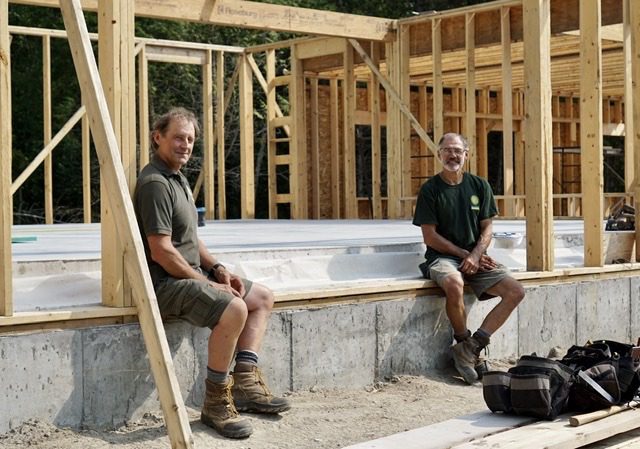by Rachel Everett-Fry, Local Journalism Initiative Reporter
Ecogen Energy & Build is at the cutting edge of home design in the face of the climate crisis. Leveraging renewable energy technologies and passive house design, EcoGen designs and manages new builds that are thrillingly innovative, thoughtful, and ultra-efficient. Part of EcoGen’s ethos is to demonstrate that living sustainably can not only be comfortable, but also cost-effective.
EcoGen President Chris Weissflog spent 21 years in the Canadian military. With his background in science, Chris recalls that his immediate interest was in solar water heating and solar electric, and he got certified as an HVAC designer in order to work toward linking the two systems. He then delved into designing hydronic systems that could best utilize the water being heated through solar power. The last piece of the puzzle was learning about passive house design. Chris was certified as a passive house designer in 2012 and went on to design the house that he and his family now call home.
While renewable energy technologies, such as solar electric or water heating systems, focus on producing clean, renewable, energy, the passive house philosophy is oriented toward minimizing energy draw no matter its source. To oversimplify, think of your average household energy consumption as a pie: in most homes, half the slices go to heating and cooling, a couple more to hot water, one or two to household appliances, and so on. The energy used to power each slice could come from a number of sources: hydro, natural gas, wood stove, solar. A passive home contains all the same slices of pie, but it’s a mini pie. When combined with clean renewables like solar, it becomes possible to live in a home with zero emissions.
For those of you already invested in sustainability, the very concept of zero footprint may raise alarm bells: nothing is immediately carbon neutral, they only become carbon neutral over time. This is indeed the case, but these homes are so efficient that it doesn’t take very long. Further, Chris’ designs focus on “using building materials that sequester carbon in the house as opposed to materials that have a net embodied carbon.”
It’s even possible to use the excess energy collected at the house to power electric cars. Chris does it. He says “Our house generates more electricity than we use every year.” They live comfortably, power an electric car, and still put energy back on the grid through Hydro. Chris warns laughingly, that it’s possible for these homes to work too well. He says his house isn’t just a passive house, but a “passive aggressive house.” He recalls the first winter he and his family shared there. “We had a week when the daytime high was minus 15 with clear skies, but it was going down to minus 30 at night. We went eight days with no heat being added to the house. When the sun was out, the temperature in the house would go up maybe a degree and a half Celsius, maybe two by dinnertime. And then, each night, we would only lose maybe one degree. The net progress was upwards. So after five days, at dinner time my wife Clare said “It’s twenty five degrees in here, I don’t care what you think. I’m opening windows.” So we’re there cooking with the windows open to cool off the house.”
The technologies involved in building a passive house rely on air- tightness, lots of insulation, energy recovery ventilation systems, designing out thermal bridges (structural elements of a home that allow for heat to move in or out), and other design elements. One of these design elements is passive solar. In his current build, Chris has designed a south facing window system that can optimally catch the rays of the sun when needed. The low winter sun at about 27 degrees can shine through these windows top to bottom. But in the summer, when the sun sits at a higher angle, an awning prevents direct sunlight from hitting the windows and, as a result, warming up the house. But these aren’t just simply awnings: they are equipped with solar panels. For Chris, passive house design has also afforded opportunities for renewables.
With this technology, it’s not unreasonable to expect a yearly hydro bill of $1,200 or less on a 2,000 square-foot home. This includes air conditioning, heat, dishwasher, etc. And this doesn’t come at an unreasonable initial cost, Chris says, “We’re trying to keep the cost of operating a house down, not just the financial cost, but the amount of energy we would need to operate a house.”
This is to say that the technology required to truly adopt a sustainable lifestyle is out there. Not far out there, it’s right here in North Grenville.






